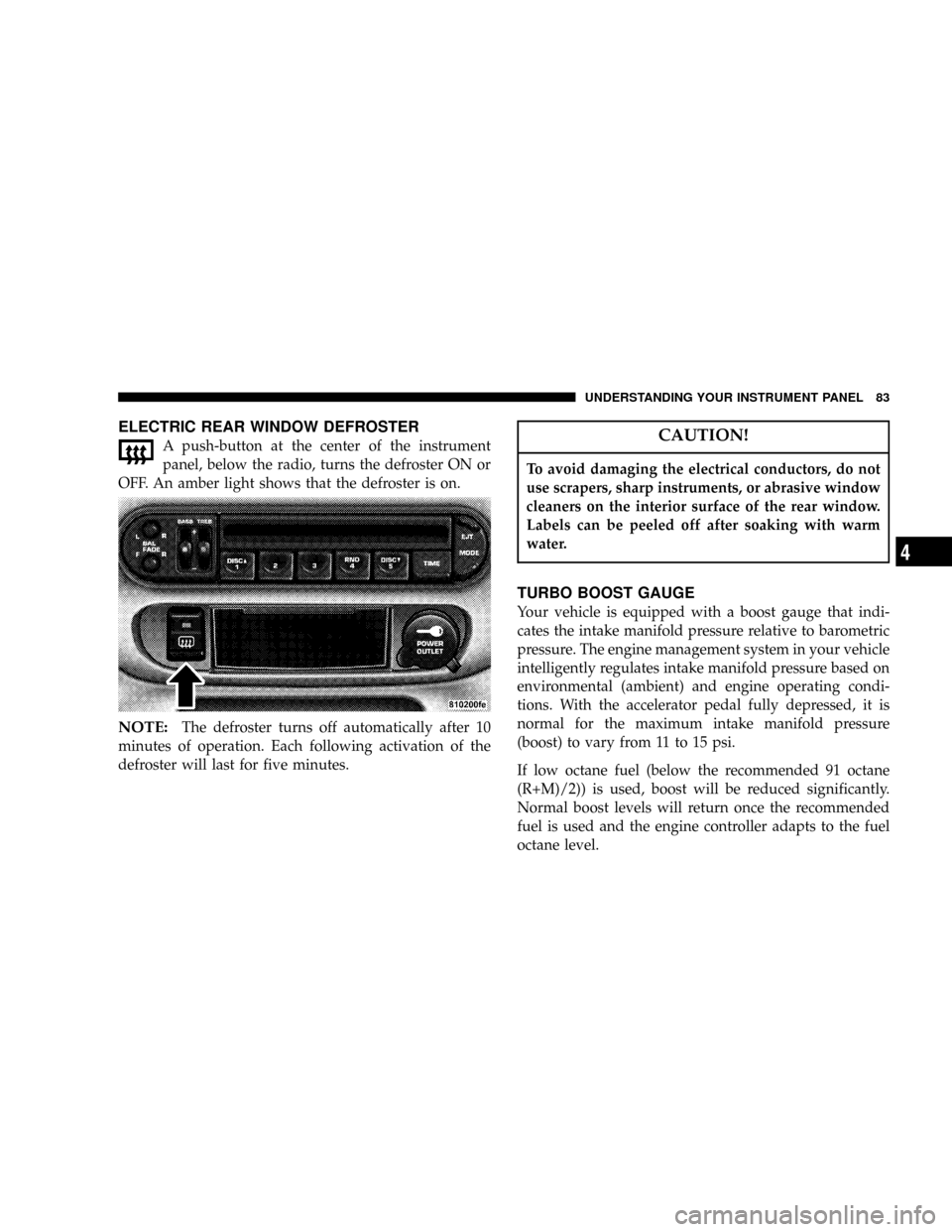Page 83 of 200

ELECTRIC REAR WINDOW DEFROSTER
A push-button at the center of the instrument
panel, below the radio, turns the defroster ON or
OFF. An amber light shows that the defroster is on.
NOTE:The defroster turns off automatically after 10
minutes of operation. Each following activation of the
defroster will last for five minutes.
CAUTION!
To avoid damaging the electrical conductors, do not
use scrapers, sharp instruments, or abrasive window
cleaners on the interior surface of the rear window.
Labels can be peeled off after soaking with warm
water.
TURBO BOOST GAUGE
Your vehicle is equipped with a boost gauge that indi-
cates the intake manifold pressure relative to barometric
pressure. The engine management system in your vehicle
intelligently regulates intake manifold pressure based on
environmental (ambient) and engine operating condi-
tions. With the accelerator pedal fully depressed, it is
normal for the maximum intake manifold pressure
(boost) to vary from 11 to 15 psi.
If low octane fuel (below the recommended 91 octane
(R+M)/2)) is used, boost will be reduced significantly.
Normal boost levels will return once the recommended
fuel is used and the engine controller adapts to the fuel
octane level.
UNDERSTANDING YOUR INSTRUMENT PANEL 83
4
Page 113 of 200

The required rotation method for directional tires is to
swap the front tire with the rear on the same side of the
vehicle. Do not cross switch tires without dismounting
the tires and re-mounting them in the correct rotational
direction.
SELECTING FUEL
2.4L TURBO
Your engine is designed to meet all emis-
sion regulations and provide excellent fuel
economy and performance when using
high quality unleaded gasoline having an
octane rating of 91. The purchase of higher
octane is not recommended.
High quality unleaded gasoline having a minumum
octane rating of 87 may safely be used for your vehicle.
Use of these lower octane gasolines, however, may result
in reduced acceleration performance.
If low octane fuel (below the recommended 91 octane
(R+M)/2)) is used, boost will be reduced significantly.Normal boost levels will return once the recommended
fuel is used and the engine controller adapts to the fuel
octane level.
Spark Knock
Light spark knock at low engine speeds is not harmful to
your engine. However, continued heavy spark knock at
high speeds can cause damage and immediate service is
required. Engine damage resulting from operation with a
heavy spark knock may not be covered by the new
vehicle warranty.
Poor quality gasoline can cause problems such as hard
starting, stalling and hesitations. If you experience these
symptoms, try another brand of ªregularº gasoline be-
fore considering service for the vehicle.
Over 40 automobile manufacturers around the world
have issued and endorsed consistent gasoline specifica-
tions (the World Wide Fuel Charter, WWFC) to define
fuel properties necessary to deliver enhanced emissions,
engine performance, and durability for your vehicle. The
manufacturer recommends the use of gasolines that meet
the WWFC specifications if they are available.
STARTING AND OPERATING 113
5
Page 114 of 200

Reformulated Gasoline
Many areas of the country require the use of cleaner
burning fuel referred to as Reformulated Gasoline. Re-
formulated gasolines contain oxygenates, and are specifi-
cally blended to reduce vehicle emissions and improve
air quality.
The manufacturer supports the use of reformulated gaso-
lines. Properly blended reformulated gasolines will pro-
vide excellent performance and durability for the engine
and fuel system components.
Gasoline/Oxygenate Blends
Some fuel suppliers blend unleaded gasoline with mate-
rials called oxygenates such as 10% ethanol, MTBE and
ETBE. Oxygenates are required in some areas of the
country during the winter months to reduce carbon
monoxide emissions. Fuels blended with these oxygen-
ates may be used in your vehicle.
CAUTION!
DO NOT use gasolines containing Methanol. Gaso-
line containing methanol may damage critical fuel
system components.
Problems that result from using methanol/gasoline
blends are not the responsibility of The manufacturer and
may not be covered by the vehicle warranty. While MTBE
is an oxygenate made from Methanol, it does not have
the negative effects of Methanol.
MMT in Gasoline
MMT is a manganese containing metallic additive that is
blended into some gasoline to increase octane. Gasolines
blended with MMT provide no performance advantage
beyond gasolines of the same octane number without
MMT. Gasolines blended with MMT have shown to
reduce spark plug life and reduce emission system
performance in some vehicles. The manufacturer recom-
mends that gasolines free of MMT be used in your
114 STARTING AND OPERATING
Page 166 of 200
RECOMMENDED FLUIDS, LUBRICANTS AND GENUINE PARTS
Engine
Component Fluids, Lubricants and Genuine Parts
Engine Coolant MopartAntifreeze/Coolant 5 Year/100,000 Mile Formula HOAT (Hybrid Or-
ganic Additive Technology)
Engine Oil Use Mobil 1t10W30 synthetic engine oil.
Engine Oil Filter Mopar 4781452AA or equiv.
Spark Plugs Refer to the Vehicle Emission Control Information label in the engine com-
partment.
Fuel Selection 91 Octane.
Chassis
Component Fluids, Lubricants and Genuine Parts.
Manual Transmission Fluid MopartATF+4 Automatic Transmission Fluid.
Brake Master Cylinder MopartDOT 3 and SAE J1703 should be used. If DOT 3 brake fluid is not
available, then DOT 4 or DOT 4+ is acceptable. Use only recommended
brake fluids.
Power Steering Reservoir MopartATF+4 Automatic Transmission Fluid.
166 MAINTAINING YOUR VEHICLE
Page 194 of 200

Downshifting........................... 92
Drive Belts............................ 140
Driving
On Slippery Surfaces.................. 128
Electric Remote Mirrors................... 48
Emergency, In Case of
Jacking............................. 122
Jump Starting........................ 125
Towing............................. 130
Emergency Trunk Release................. 15
Emission Control System Maintenance....... 168
Engine
Break-In Recommendations............... 42
Checking Oil Level.................... 137
Jump Starting........................ 125
Oil ..........................137,165,166
Oil Change Interval................... 138
Oil Filter............................ 166
Oil Selection......................... 138
Oil Synthetic......................... 139
Overheating......................... 120
Temperature Gauge.................... 67Timing Belt.......................... 142
Exhaust Gas Caution..................... 43
Exhaust System........................ 147
Filters
Air Cleaner.......................... 142
Engine Fuel......................... 142
Engine Oil.......................140,166
Flooded Engine Starting................... 88
Fluid, Brake........................... 166
Fluid Capacities........................ 165
Fluid Leaks............................ 44
Fluid Level Checks
Manual Transaxle..................... 155
Fog Lights...........................54,63
Freeing A Stuck Vehicle.................. 129
Fuel.............................. 113,166
Adding............................. 116
Filler Cap........................... 116
Filter.............................. 142
Gauge.............................. 65
Light............................... 65
Octane Rating........................ 113
194 INDEX